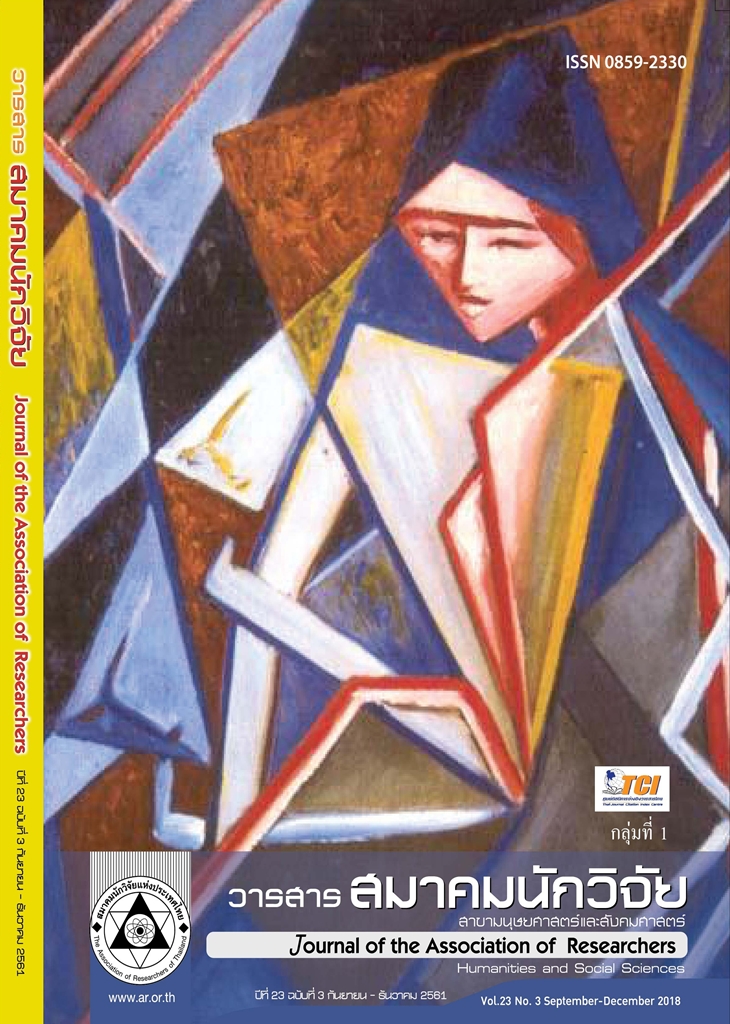Influences of Socially Responsible Leadership and Service Quality on Corporate Image of Anantara Riverside Bangkok Resort
Main Article Content
Abstract
The purposes of this research were 1) to study of structural relationship between socially responsible leadership service quality and corporate image of Anantara Riverside Bangkok Resort 2) to study the influence of socially responsible leadership on service quality 3) to study the influence of socially responsible leadership on corporate image both direct and indirect via service quality and 4) to study the influence of service quality on corporate image of Anantara Riverside Bangkok Resort. The Samples were 300 employees. The research results found that 1) correlation coefficient among observable variables were 0.423 - 0.632 and every variable had a significant level, 2) socially responsible leadership had direct effect to service quality in higher at the statistical significance (SRLDgSQT, γ= 0.58, p < 0.01) and variance predicted by socially responsible leadership with 68 percent, 3) socially responsible leadership had directly effect to corporate image in higher at the statistical significance (SRLDgIMG, γ= 0.65, p < 0.01) and had indirect effect via service quality in lower at the statistical significance (SRLDgSQTgIMG, γβ= 0.20, p < 0.01 and variance predicted by socially responsible leadership with 80 percent, and 4) service quality had effect to corporate image in middle level at the statistical significance (SQTgIMG, β= 0.36, p < 0.05). Fit indices of the model were X2 / df = 0.941, CFI = 1.00, NNFI = 1.00, RMSEA = 0.00 and 90% CI for RMSEA = 0.00.
Article Details
บทความที่ปรากฏในวารสารนี้ เป็นความรับผิดชอบของผู้เขียน ซึ่งสมาคมนักวิจัยไม่จำเป็นต้องเห็นด้วยเสมอไป การนำเสนอผลงานวิจัยและบทความในวารสารนี้ไปเผยแพร่สามารถกระทำได้ โดยระบุแหล่งอ้างอิงจาก "วารสารสมาคมนักวิจัย"
References
จิรัชญา โยธาอภิรักษ์. (2551). ปัจจัยที่มีอิทธิพลต่อภาพลักษณ์ด้านความรับผิดชอบต่อสังคมของบริษัท ปตท. จำกัด (มหาชน) และผลของภาพลักษณ์ต่อทัศนคติที่มีต่อตราสินค้า ปตท. วิทยานิพนธ์นิเทศศาสตรมหาบัณฑิต สาขาวิชาการ ประชาสัมพันธ์ธุรกิจ, มหาวิทยาลัยหอการค้าไทย.
พิพัฒน์ นนทนาธรณ์. (2558ก). ภาวะผู้นําเชิงปฏิบัติการ: LIFE Model. (พิมพ์ครั้งที่ 2). กรุงเทพมหานคร: ศูนย์ผู้นำธุรกิจ เพื่อสังคม มหาวิทยาลัยเกษตรศาสตร์.
__________ (2558ข). “ปัจจัยเชิงสาเหตุของภาวะผู้นำที่รับผิดชอบต่อสังคมที่มีอิทธิพลต่อภาพลักษณ์องค์การของท่า อากาศยานสุวรรณภูมิ.” วารสารสมาคมนักวิจัย 20 (2): 48-58.
__________ (2559). “อิทธิพลของภาวะผู้นำที่รับผิดชอบต่อสังคม การรับรู้ของผู้มีส่วนได้ส่วนเสียด้านความรับผิดชอบ ต่อสังคมขององค์การที่ส่งผลต่อภาพลักษณ์องค์การของท่าอากาศยานเชียงใหม่.” วารสารสมาคมนักวิจัย 21 (2): 202-214.
เมธาพร หิรัญญธนกิจ. (2556). การศึกษาปัจจัยเชิงสาเหตุระหว่างการรับรู้กิจกรรมความรับผิดชอบต่อสังคมขององค์กร คุณลักษณะผลิตภัณฑ์ และภาพลักษณ์องค์กร บริษัท เอส แอนด์ พี ซินดิเคท จํากัด (มหาชน). วิทยานิพนธ์ บริหารธุรกิจมหาบัณฑิต สาขาวิชาบริหารธุรกิจ, มหาวิทยาลัยเกษตรศาสตร์
References
Cheney, G. and S. L. Vibbert. (1987). Corporate Discourse: Public relations and issue management. Newbury Park, CA: Sage.
Dutton, J. E. and J. M. Dukerich. (1991). Keeping an eye on the mirror Image and identity in organizational adaptation. Academy of Management Journal 34(3): 517-554.
Dutton, J. E., J. M. Dukerich and Harquail, C. V. (1994). Organizational images and member identification. Administrative Science Quarterly 39: 239-263.
Huang, C. C., S. W. Yen., C. Y. Liu. and P. C. Huang. (2014). The relationship among corporate social responsibility, service quality, corporate image and purchase intention. International Journal of Organizational Innovation (Online) 6 (3): 68.
Liu, Y., and Ji, H. (2010). A study on the perceived CSR and customer loyalty based on dairy market in China. In Service Systems and Service Management (ICSSSM), 2010 7th International Conference on (pp. 1-6).
IEEE. Moffitt, M. A. (1994). Collapsing and integrating concepts of ‘public’ and ‘image’ into a new theory. Public Relations Review 20 (2): 159-170.
Waldman, D. A. (2007). “Best practices in leading at strategic levels: A social responsibility perspective.” The Practice of Leadership: Developing the Next Generation of Leaders 20 (2): 224-243.
Zeithaml, V. A., Parasuraman, A., Berry, L. L., and Berry, L. L. (1990). Delivering Quality Service: Balancing Customer Perceptions and Expectation. New York: The Free Press.
Translated Thai References
Hiranyathanakij, M. (2013). The Causal Factor of CSR Activity Perception Product Attribute and Corporate Image Case Study : S&P Syndicate Public Company Limited. Master Thesis in Business Administration, Kasetsart University. (in Thai).
Ministry of Tourism and Sports. (2018). Tourism Statistics 2017 (Online). Retrieved January, 20, 2018, from www.mots.go.th. (in Thai).
Nonthanathorn, P. (2015a). Operational Leadership: LIFE Model. (2nd ed.). Bangkok: Social Enterprise Leadership Center. (in Thai).
________ (2015b). Causal Factors of Socially Responsible Leadership Influencing to Corporate Image of Suvarnabhumi Airport. Journal of the Association of Researchers, 20 (2): 48-58.. (in Thai).
________ (2016). Influences of Socially Responsible Leadership and Stakeholders’ Perception of Corporate Social Responsibility on Corporate Image of Chiang Mai International Airport. Journal of the Association of Researchers, 20 (2): 48-58. (in Thai).
Yotha-apirax, C. (2008). Factors Influencing the Corporate Social Responsibility (CSR) Image of the PTT Public Company Limited and the Effect of the Image on Attitudes toward the PTT Product Brand. Master Thesis in Communication Arts Department of Business Public Relations, University of the Thai Chamber of Commerce. (in Thai).


